

Author: Kent Moors, Ph.D.
Before we dive into this installment of the Classified Intelligence Brief Spy Tales series, some personal background is necessary.
Toward the end of the last century (still seems curious to say that), I had finally transitioned to a primary residence back in the States. For almost two decades I had held down professorial appointments in both the eastern US and London. My American university was very understanding (in fact, the campus remains the best place for staff and students also having government or military service obligations). Yet my life would make for some creative class syllabi and a lot of shuttle travel. With the move back, I had expected my schizophrenic life would finally be more manageable.
But everything has a price.
My main responsibility continued to be in CI (counterintelligence), but the scope had expanded with everything happening abroad. Beginning in the mid-1990s, and for more than twenty years thereafter, my responsibilities gravitated about what one superior tongue-in-cheek called “being a pencil.” Sometimes I was the point of the operation. Sometimes I would be the eraser.
I could be called up and sent off on one TDY or other on a noticeably short turn around. It was “affectionately” called “72-hour notice.” The phrase came more from the bean counters at HQ than anything else because the assignment often took longer and the “notice” would usually be much shorter than three days. Literally, for years on end, I had a packed suitcase along wherever I was. I would be put on a government plane, thrown some briefing books, and we were off to the races.
Made for some interesting times. Now, you have been at a place too long when this happens. Toward the end of my teaching career, I had a student come up and say, “Looking forward to taking this class,” then adding, “because my dad said when he took your class…”
But the smart-alecky freshman then recounted stories from his father about guys in suits pulling me out mid lecture, whereupon one of my (three) grad teaching assistants would miraculously appear to finish the class session.
The schedule did become easier when my university days were over. However, the assignments did not. Usually, the damage had already been done before I even set foot on the ground. The operation was usually blown, there was occasionally collateral damage, and whatever in country support net had been set up was long gone. Too frequently, I would recall that corollary to Murphy’s Law: “The smiling administrator during times of crisis has figured out who to blame it on.”
Most of us have some version of a “bucket list,” things to do before “kicking the bucket.” Mine have always been places I would like to visit.
I had several of these lists and filled them up early. But when I managed to get Marina out of Moscow toward the end of the Cold War (sorry, while “mother” has no choice but to acknowledge the event happened, I am not yet allowed to talk about the op connected to it, or for that matter just about any of my activities in the USSR) and we were married, the exercise changed. We have traveled extensively (and intend to do so once the COVD pandemic has abated). Yet there is one main list I promised to her.
These are my personal “Ten Physical Wonders of the World.” I had been to most of these before, but Marina had not. And, frankly, these are the places I most wanted to show her. So, this became our ultimate bucket list.
Half are on the “yet to do” side of the list: Machu Picchu (Peru); Angkor Wat (Cambodia); the Giza pyramid complex and Luxor (Egypt); an extended cruise up the Sognefjord (western Norway); and the Great Wall (China).
We have checked off the other five: The Grand Canyon; the Temple at Delphi in the mountains outside Athens; the Bernina Pass (Switzerland) from St. Moritz to Val Poschiavo (the most awesome 35-mile drive through the Alps you can imagine); the view from the summit of Corcovado (and the famous Christ the Redeemer statute) overlooking Rio de Janeiro; and the mouth dropping location of this week’s Spy Tale entry.
This is Iguazu Falls on the border between Brazil and Argentina (with Paraguay a stone’s throw away). Both nations have set aside the environs as national parks with the entire area designated a UNESCO World Heritage site. Calling it spectacular does not begin to do it justice.
Iguazu is why Niagara Falls never made it on my list. Marina and I have visited Niagara three times and the Canadian side will serve as the subject of a later Spy Tale.
But Iguazu has hundreds of cascading waterfalls cutting through the jungle. And most of them are higher than either of the falls at Niagara. It makes no difference which national side of the gorge you use as your frame of reference. There are simply no adequate words to describe what you see. The site is so vast and breathtaking, no single picture below 10,000 feet can provide even most of it. Take the following photos, for example, all taken from the UNECSO World Heritage site: whc.unesco.org/en/documents/.
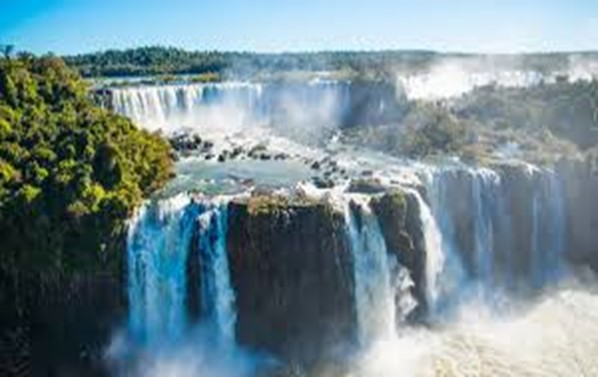



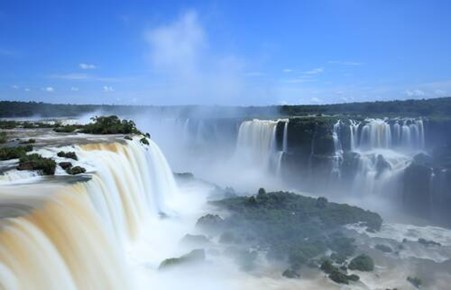

The Iguazu River meanders west for some 750 miles, ultimately to flow into the Paraná River at the so-called “Triple Frontier,” where Brazil, Argentina, and Paraguay meet. The falls are just upriver from that border convergence.
Which finally brings us to the tale this time around. This one takes place in late 2015. I retired from my university gigs over a year earlier and had moved heavily into global consulting. The “other job,” however was still ongoing.
I had been advising on new natural gas finds in Argentina (for national oil and gas company YPF) while providing some market risk analysis for the Brazilian state oil company Petróleo Brasileiro S.A. (Petrobras) which extended into other natural resources. I was to schedule my next visit anyway. But a matter arose that required some expedited travel.
On November 5, 2015, the Mariana dam disaster occurred. This was actually the collapse of an earthen tailings dam (the Fundão dam) at the Germano iron ore mine operated by Samarco Mineração SA near Mariana in the state of Minas Gerais upriver from Iguazu. The dam had held residue from mining operations (i.e., tailings).
Two FYI matters. First, I had been to Mariana during my Petrobras work. It is a beautiful baroque city, founded in the late 1600s and exhibiting the Portuguese colonial influence of its early period. Today, it is a popular tourist attraction.
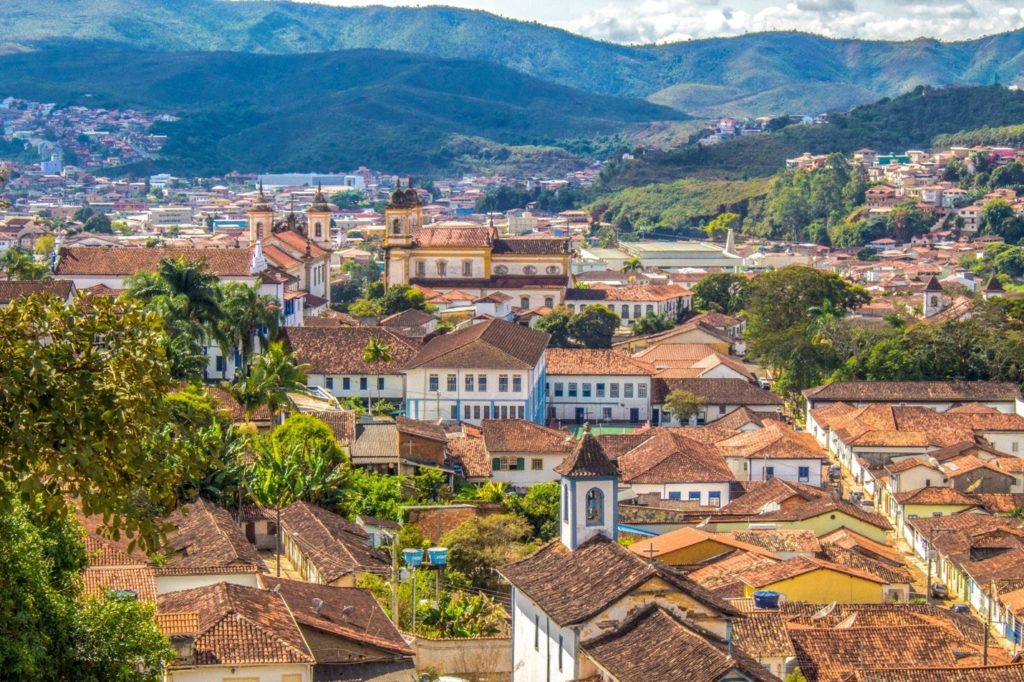

Second, Samarco is a 50-50 joint venture between Brazilian miner Vale and Australian BHP. The acrimony between Samarco and other local mining companies had centered about foreign control over domestic mineral rights. The dam disaster merely brought this up to a fever pitch.
Mariana itself was spared damage. But other close by locations were not as fortunate. The village of Bento Rodrigues on the Doce River was flattened with the mud and tailings polluting water all the way back to the Atlantic Ocean. The Mariana dam disaster became the worst environmental event in Brazilian history.
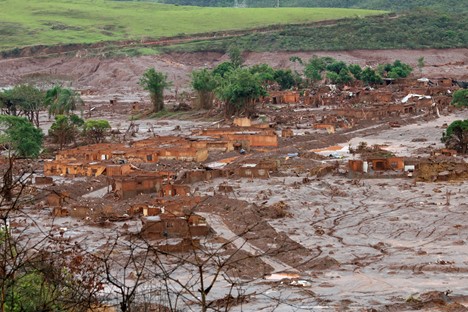

ASIS (the Australian Secret Intelligence Service) requested assistance under an intelligence codicil to the 1951 ANZUS collective security pact (NZ standing for New Zealand, the third party to the agreement). Their intel had indicated active foreign covert involvement in the dam collapse. Apparently, the Aussies had concluded there were indications that local opposition to foreign mining activities in Brazil (and, thereby, opposition to Australian interests) had now extended to attract activity from other outside parties.
I was put into a hastily drawn up assignment to determine whether the intel received had any substance. Brazil, Argentina, and Paraguay had begun another round in an ongoing diplomatic tiff over ownership of hydrocarbon basins abutting the Triple Frontier.
Some of the prime reserves are located in Brazil’s Iguazu National Park and are strictly off limits. But that hardly meant they were off the radar for private developers intent on figuring out ways to circumvent national policy.
All of this political background noise provided sufficient cover if outside influence was being exerted.
Since I had to go back to the area anyway, I brought Marina along and centered activity at Iguazu. That allowed us to tick off another place on the list while I surveyed what was happening.
OK, it is a busman’s holiday. But at least the scenery was amazing. And not just the waterworks. This an ecological marvel.
Now there were masses of tourists touring the falls and park daily. However, Brazilian regulations required that all of them leave by six o’clock each evening. This remains a very delicate ecosystem, especially at night.
The hundreds of indigenous mammal, bird, and reptile species include the pervasive coati, who may look cute but are not to be trifled with.
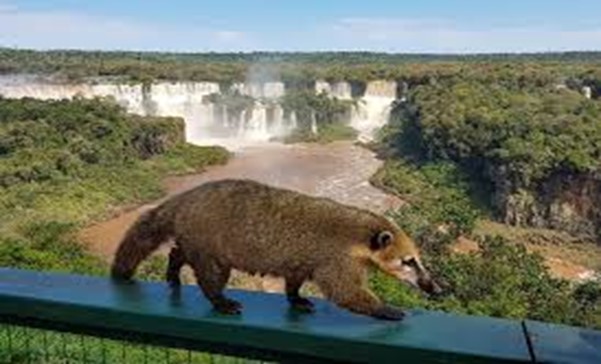

This is also a preserve for jaguars, although their habitat has been progressively pushed further into the bush. Still, you can upon occasion hear them in the distance if you are well into the park (the sound from cascading water makes hearing anything difficult closer to the falls). Then there are the large and uncomfortable tegu lizards.
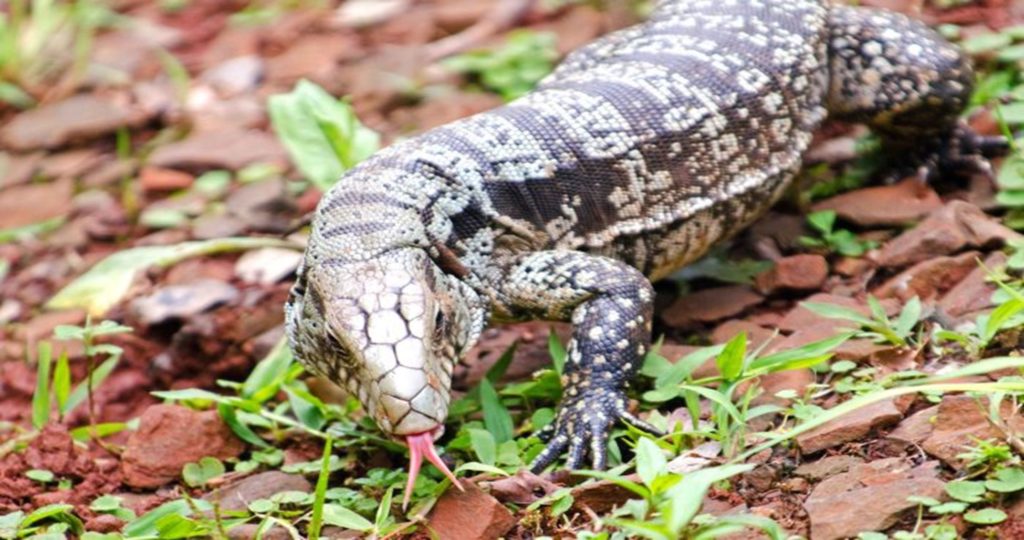

There is one exception to the “get out of town by sundown rule.” The five-star luxury Hotel das Cataratas (an entry in the exclusive Belmond chain) is right by the falls on the Brazilian side and its residents are the only ones allowed to remain in the park at night. It was our base for an eight-day stay.
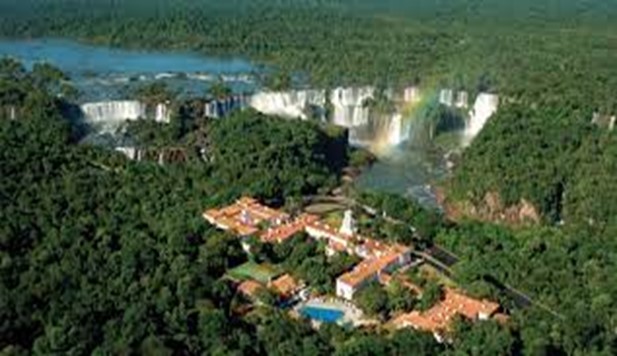

This is also the only restaurant in which we have ever eaten caldo de piranha (piranha soup!).


We flew into Iguazu from Miami via Lima, Peru. That allowed me to receive updates during a stopover before we landed in far southwestern Brazil. By the time I arrived, the dam collapse had become major national news, animosity to foreign company investment was growing, and several of the Samarco execs were about to be arrested.
This was quickly descending into a political maelstrom.
My contacts at Petrobras and YPF provided their own privately sourced intel indicating the collapse resulted from Samarco delaying mandated (and expensive) upgrades. The work had been required by both the state of Minas Gerais and the central government in Brasilia. Ultimately, several officers (all from Vale, the Brazilian member of the joint venture, not Australian BHP) went to jail.
Of course, that would not have prevented other folks from attempting to take advantage of the situation. But the initial (and somewhat “veiled”) ASIS suggestion that the disaster was caused from the outside quickly fell apart.
That still left the aftermath problem. SIGINT (signals intelligence) had picked up an increase in chatter from the usual sources on manipulating media and other venues to create more problems for Western companies in Brazil and, to a lesser extent, Argentina.
It is here that I found some evidence for another take altogether. Opposition agencies would always try to take advantage of a situation like this. We had as well on other occasions for our own purposes.
What I found interesting was the total lack of involvement by the third country impacted here – Paraguay. True, the Paraguayan government filed concerns over the integrity of regional waterways, but there was no contribution from Sinai, the country’s National Intelligence System. Sinai had been created only a year earlier, finally taking over from a very complicated network of public and private intel agencies that had populated Paraguay for generations.
I had no contacts in Sinai, but the agency advised use of a part time agent (somebody else’s citizen working for us). We met outside of Presidente Franco, a small Paraguayan enclave less than five miles from Iguazu. This is a porous border to say the least. While main thoroughfares and connections moving into the center of the town have passport locations, it is an easy matter to cross from one country to the other in the jungle. I took my documents but never met anybody to show them to.
The agent provided some information that officials and companies in Paraguay had interest in directing the ongoing tri-partite diplomatic negotiations to investments favoring them rather than Brazil or Argentina. That included using the Mariana disaster as a prime focus. Two of the companies involved had Chinese partners (always an unusual sign in the middle of the jungle).
My problem was this. I did not have the assets in place to authenticate any of this, while the agent had a grade of 2×2. Each agent worldwide was graded from 1 to 5 in two areas: accuracy of prior information and how close they were to the sources. You would be provided the grade but not the specifics behind it, thereby allowing the agent some security. A 2×2 was a mediocre grade at best. It provided no confidence at all.
Anyway, everything was sent up the chain with a response requested. Less than 12 hours later it came – an instruction to stand down. No reason was ever given for why (you rarely if ever get one), although I surmised this drama was now playing out somewhere else.
I decided the hell with it and took Marina sightseeing. The next day we went out to the Parque de Aves, South America’s largest bird sanctuary located within the Iguazu National Park.


Could always get it reimbursed as an operation-related expense. You know, maintaining cover and all that. Nonetheless, I still made an effort to do the job. Unfortunately, none of the thousands of Parque locals had any useful intel.


This is an installment of Classified Intelligence Brief, your guide to what’s really happening behind the headlines… and how to profit from it. Dr. Kent Moors served the United States for 30 years as one of the most highly decorated intelligence operatives alive today (including THREE Presidential commendations).
After moving through the inner circles of royalty, oligarchs, billionaires, and the uber-rich, he discovered some of the most important secrets regarding finance, geo-politics, and business. As a result, he built one of the most impressive rolodexes in the world. His insights and network of contacts took him from a Vietnam veteran to becoming one of the globe’s most sought after consultants, with clients including six of the largest energy companies and the United States government.
Now, Dr. Moors is sharing his proprietary research every week… knowledge filtered through his decades as an internationally recognized professor and scholar, intelligence operative, business consultant, investor, and geo-political “troubleshooter.” This publication is designed to give you an insider’s view of what is really happening on the geo-political stage.
You can sign up for FREE to Classified Intelligence Brief and begin receiving insights from Dr. Moors and his team immediately.
Just click here – https://classifiedintelligencebrief.com/






